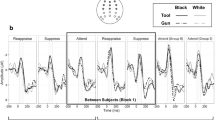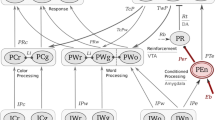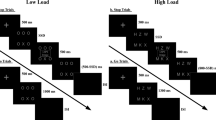Abstract
Evidence for performance deficits in psychopathic offenders on emotional processing tasks have been documented. However, studies that show performance improvements or elimination of anomalies under certain conditions are not consistent with a general insensitivity to emotion stimuli. The current study tests the hypothesis set forth by the Affect Regulation Theory (Penney and Kosson, manuscript submitted to Clinical Psychological Science) that psychopathic participants’ performance on an affective lexical decision task will reflect a speed-accuracy trade-off wherein accuracy on emotion-word trials correlates with response latency among psychopathic participants but not controls. Participants were 86 incarcerated male offenders divided into three groups using scores on the Psychopathy Checklist-Revised and DSM-IV criteria for ASPD (non-ASPD/non-psychopathic, ASPD/non-psychopathic; and ASPD + psychopathic). There was a significant Group x Response latency interaction for negative word trials, with greater accuracy associated with slower response times on negative word trials for ASPD + psychopathic individuals but not for the other groups. The implications of these results for hypotheses about emotional functioning in psychopathic offenders and for the recently proposed ART are discussed.
Similar content being viewed by others
Notes
Accuracy and response latency data from this lexical-decision task were previously presented in Lorenz and Newman (2002). However, the analyses for that study examined latency only for correct responses and did not address speed-accuracy relationships.
References
Arbuckle, N. L., & Shane, M. S. (2016). Up-regulation of neural indicators of empathic concern in an offender population. Social Neuroscience, 12, 386–390.
Baskin-Sommers, A., Curtin, J. J., & Newman, J. P. (2011). Specifying the attentional selection that moderates the fearlessness of psychopathic offenders. Psychological Science, 22, 226–234.
Baskin-Sommers, A., Curtin, J. J., Li, W., & Newman, J. P. (2012). Psychopathy-related differences in selective attention are captured by an early event-related potential. Personality Disorders: Theory, Research, and Treatment, 3, 370–378.
Blair, R. J. R. (2006). The emergence of psychopathy: Implications for the neuropsychological approach to developmental disorders. Cognition, 101, 414–442.
Blair, K. S., Morton, J., Leonard, A., & Blair, R. J. R. (2006). Impaired decision-making on the basis of both reward and punishment information in individuals with psychopathy. Personality and Individual Differences, 41, 155–165.
Brook, M., & Kosson, D. S. (2013). Impaired cognitive empathy in criminal psychopathy: Evidence from a laboratory measure of empathic accuracy. Journal of Abnormal Psychology, 122, 156–166.
Brook, M., Brieman, C. L., & Kosson, D. S. (2013). Emotion processing in psychopathy checklist—assessed psychopathy: a review of the literature. Clinical Psychology Review, 33, 979–995.
Chapman, L. J., & Chapman, J. P. (1987). The measurement of handedness. Brain and Cognition, 6, 175–183.
Christian, E. J., Meltzer, C. L., Thede, L. L., & Kosson, D. S. (2017). The relationship between early life events, parental attachment, and psychopathic tendencies in adolescent detainees. Child Psychiatry and Human Development, 48, 260–269.
Cleckley, H. (1976). The Mask of Sanity (5th Ed.). St. Louis: Mosby.
Dawel, A., O’Kearney, R., McKone, E., & Palermo, R. (2012). Not just fear and sadness: Meta- analytic evidence of pervasive emotion recognition deficits for facial and vocal expressions in psychopathy. Neuroscience and Biobehavioral Reviews, 36, 2288–2304.
Edalati, H., Walsh, Z., & Kosson, D. S. (2016). Attentional bias in psychopathy: An examination of the emotional dot-probe task in male jail inmates. International Journal of Offender Therapy and Comparative Criminology, 60, 1344–1357.
Eisenbarth, H., Alpers, G. W., Segrè, D., Calogero, A., & Angrilli, A. (2008). Categorization and evaluation of emotional faces in psychopathic women. Psychiatry Research, 159, 189–195.
Ermer, E., Kahn, R. E., Salovey, P., & Kiehl, K. A. (2012). Emotional intelligence in incarcerated men with psychopathic traits. Journal of Personality and Social Psychology, 103, 194–204.
Flight, J. I., & Forth, A. E. (2007). Instrumentally violent youths: The roles of psychopathic traits, empathy, and attachment. Criminal Justice and Behavior, 34, 739–751.
Glenn, A. L., Raine, A., Venables, P. H., & Mednick, S. A. (2007). Early temperamental and psychophysiological precursors of adult psychopathic personality. Journal of Abnormal Psychology, 116, 508–518.
Hare, R. D. (1978). Electrodermal and cardiovascular correlates of psychopathy. In R. D. Hare & D. Schalling (Eds.), Psychopathic behavior: Approaches to research. New York: Wiley.
Hare, R. D. (1991). The hare psychopathy checklist—revised. Toronto: Multi-Health Systems.
Hare, R. D. (1999). Without conscience: The disturbing world of the psychopaths amongst us. New York: Guilford Press.
Hare, R. D., Frazelle, J., & Cox, D. N. (1978). Psychopathy and physiological responses to threat of an aversive stimulus. Psychophysiology, 15, 165–172.
Intrator, J., Hare, R., Stritzke, P., Brichtswein, K., Dorfman, D., Harpur, T., et al. (1997). A brain imaging (single photon emission computerized tomography) study of semantic and affective processing in psychopaths. Biological Psychiatry, 42, 96–103.
Kosson, D. S., McBride, C. K., Miller, S. A., Riser, R. E., & Whitman, L. A. (2017). Attentional bias following frustration in youth with psychopathic traits: emotional deficit versus negative preception. Journal of Experimental Psychopathology. https://doi.org/10.5127/jep.060116.
Larson, C. L., Baskin-Sommers, A. R., Stout, D. M., Balderston, N. L., Curtin, J. J., Schultz, D. H., Kiehl, K. A., & Newman, J. P. (2013). The interplay of attention and emotion: Top-down attention modulates amygdala activation in psychopathy. Cognitive, Affective, & Behavioral Neuroscience, 13, 757–770. https://doi.org/10.3758/s13415-013-0172-8.
Lemos Vasconcellos, S. J., Salvador-Silva, R., Gauer, V., & Chittó Gauer, G. J. (2014). Psychopathic traits in adolescents and recognition of emotion in facial expressions. Psicologia: Reflexão e Crítica, 27, 768–774.
Levenston, G. K., Patrick, C. J., Bradley, M. M., & Lang, P. J. (2000). The psychopath as observer: Emotion and attention in picture processing. Journal of Abnormal Psychology, 109, 373–385.
Lorenz, A. R., & Newman, J. P. (2002). Deficient response modulation and emotion processing in low-anxious Caucasian psychopathic offenders: Results from a lexical decision task. Emotion, 2, 91–104.
Lykken, D. T. (1957). A study of anxiety in the sociopathic personality. The Journal of Abnormal and Social Psychology, 55, 6–10.
Lykken, D. T. (1995). The antisocial personalities. Hillsdale. Erlbaum.
Lykken, D. T., & Tellegen, A. (1974). On the validity of the preception hypothesis. Psychophysiology, 11, 125–132.
Lykken, D. T., Macindoe, I., & Tellegen, A. (1972). Preception: Autonomic response to shock as a function of predictability in time and locus. Psychophysiology, 9, 318–333.
Malterer, M. B., Glass, S. J., & Newman, J. P. (2008). Psychopathy and trait emotional intelligence. Personality and Individual Differences, 44, 735–745.
Mills-Koonce, W. R., Wagner, N. J., Willoughby, M. T., Stifter, C., Blair, C., & Granger, D. A. (2014). Greater fear reactivity and psychophysiological hyperactivity among infants with later conduct problems and callous-unemotional traits. Journal of Child Psychology and Psychiatry, 56, 147–154.
Mullins-Nelson, J. L., Salekin, R. T., & Leistico, A. R. (2006). Psychopathy, empathy, and perspective-taking ability in a community sample: Implications for the successful psychopathy concept. The International Journal of Forensic Mental Health, 5, 133–149.
Newman, J. P., Curtin, J. J., Bertsch, J. D., & Baskin-Sommers, A. R. (2010). Attention moderates the fearlessness of psychopathic offenders. Biological Psychiatry, 67, 66–70.
Ogloff, J. R., & Wong, S. (1990). Electrodermal and cardiovascular evidence of a coping response in psychopaths. Criminal Justice and Behavior, 17, 231–245.
Patrick, C. J., Bradley, M. M., & Lang, P. J. (1993). Emotion in the criminal psychopath: Startle reflex modulation. Journal of Abnormal Psychology, 102, 82–92.
Riser, R. E. (2014). An examination of maladaptive emotion regulation strategies in adult psychopathic offenders. Rosalind Franklin University of Medicine and Science, United States: Unpublished dissertation.
Rubin, D. C., & Friendly, M. (1986). Predicting which words get recalled: Measures of free recall, availability, goodness, emotionality, and pronounceability for 925 nouns. Memory and Cognition, 14, 79–94.
Williamson, S., Harpur, T. J., & Hare, R. D. (1991). Abnormal processing of affective words by psychopaths. Psychophysiology, 28, 260–273.
Zachary, R. A. (1986). Shipley Institute of Living Scale: Revised manual. Los Angeles: Western Psychological Services.
Funding
This research was supported by National Institute of Mental Health Grant MH-53041.
Author information
Authors and Affiliations
Corresponding author
Ethics declarations
Ethical Approval
All procedures performed in studies involving human participants were in accordance with the ethical standards of the institutional and/or national research committee and with the 1964 Helsinki declaration and its later amendments or comparable ethical standards.
Informed Consent
Informed consent was obtained from all individual participants included in the study.
Conflicts of Interest
Jennifer Vitale, David Kosson, Zachary Resch, and Joseph Newman declare that they have no conflict of interest.
Rights and permissions
About this article
Cite this article
Vitale, J., Kosson, D.S., Resch, Z. et al. Speed-Accuracy Tradeoffs on an Affective Lexical Decision Task: Implications for the Affect Regulation Theory of Psychopathy. J Psychopathol Behav Assess 40, 412–418 (2018). https://doi.org/10.1007/s10862-018-9652-z
Published:
Issue Date:
DOI: https://doi.org/10.1007/s10862-018-9652-z




